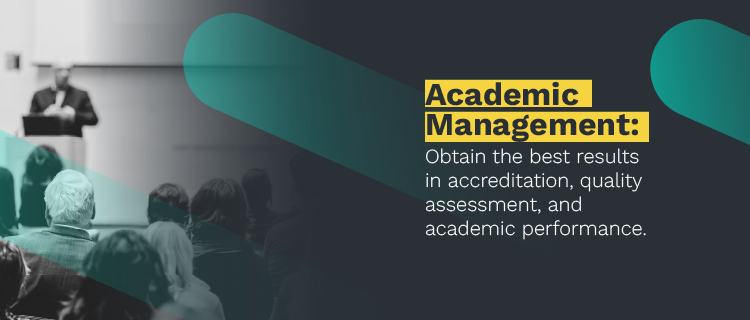Guide to a successful academic accreditation process
Accredited universities and programs are assured to meet the needs of their students, preparing graduates for their careers, and to respond to the needs of professions and of the world, thanks to a practice of ongoing self-assessment and continuous improvement. This process must be initiated by the institution, and it can take months or even years, depending on the accreditation, be it AACSB, ABET, NEASC, MSCHE or any other.
While different accreditation organizations may have specific requirements, the process usually encompasess the same broad steps, and the actions previous to the accreditation itself are as important, if not more, to obtain a favorable response. Those can be defined as:
- Internal Review & Formal Accreditation Request
- Campus Visit
- Review and Accreditation Decision
However, before seeking accreditation, institutions—or programs, depending on the type of accreditation—should determine if they fall into certain categories and if the particular eligibility requirements are met. To do this, it is essential to review the resources and documentation accrediting organizations usually provide through their websites or by contacting them directly. Also, the initiating party must have a functioning assessment process in place before going ahead with academic accreditation.
Self-assessment is key for the academic accreditation process
A mission statement and a timeline are required to define a purpose and set goals. Universities establish institutional mission statements to describe the groups they serve and the services they provide, and they task assessment leaders with creating strategies and timetables. Additionally, faculty and administrators should collaborate to create a plan of action and a timeline to ensure that assessment goals and deadlines are met.
Also, educational objectives and student outcomes should be defined. In the case of a program accreditation, the target audience is used to establish educational objectives, which are expressed as general statements of what students should know and be able to do upon graduation. Faculty can achieve consensus on student learning expectations by establishing objectives and student outcomes because they express the same expectations across the curriculum. Performance indicators gauge whether students have the requisite knowledge, skills, attitudes, and behaviors by the time of graduation.
Designing and conducting assessments provides a structure through which you may evaluate student achievement and program educational objectives. Assessments are most effective when they employ objective, indirect, quantitative, and qualitative measures that are appropriate for the outcome or objective being measured.
While assessing education practices and methods, you must be aware of how they are related. Mapping educational strategies (which might include co-curricular activities) to learning objectives may be used to accomplish this. The data collection and interpretation must be systematic and consistent, and the strategy must focus on assessment of performance indicators.
The data and evidence accumulated through the assessment process are interpreted during the evaluation phase and used to determine whether student outcomes and educational objectives are being met. Evaluation is essential in ensuring that decisions and actions resulting from the assessment process lead to improvements because of its findings.
The main steps in the academic accreditation process
Internal Review & Formal Accreditation Request
Programs and institutions seeking initial accreditation by a commission for which they have not previously been granted accreditation usually undergo some sort of readiness review and are required to carry out a preliminary self-assessment report, which is crucial, as its results will eventually be required. An initial review will help determine whether or not the program or institution is ready to submit a formal accreditation request. Some processes may even require institutions to become members of the accrediting organizations.
When an institution is satisfied with its capacity of meeting accreditation requirements, has established assessment processes, and has completed the readiness review, eligible programs may begin the accreditation process by filing a formal request with the accrediting body. Requests should usually be accompanied by official transcripts from recent graduates, and in some cases certified or official translations are required for international accreditation.
Campus Visit
After the first steps have been completed successfully, a visit to the institution’s campus will be scheduled for evaluators to assess several aspects of the process first hand. Your institution may be responsible for providing materials that may be subject to evaluation, or scheduling meetings and interviews to faculty, staff and students. The results of these evaluation visits will usually be shared at the end during a meeting but the process may vary depending on the accrediting body.

Accreditation Review and Final Decision
After the visit, institutions are usually provided with some time to work on weaknesses that the initial evaluation may have pointed out. This can kickstart a back and forth between the University and the accrediting organization that can last a few months, depending on the amount and severity of the adjustments needed. This is precisely why understanding an accreditation’s requirements and having a strong institutional self-assessment framework is so important, as it can reduce accreditation time significantly.
Only after the institution has met every requirement of every possible category, will the decision of granting accreditation will be communicated. However, the process does not end there. Most academic accreditations require institutions to build and execute self-improvement plans to guarantee that quality standards will be kept and hopefully improved in anticipation of the upcoming re-accreditation process.
Characteristics of a constructive accreditation process
Universities and accreditation agencies can both benefit from the process, even if it does not result in certification. Although most institutions have the capabilities to succeed in every accreditation process, an undeniable advantage is that Universities receive outside views from experts to help them improve. In any case, both parties should work towards ensuring that students receive quality education.
- Open and regular communication between the accreditation agency and the institution is critical to express praise or concerns regarding specifications, requirements and potential outcomes.
- Experts involved in the process must possess both a deep grasp of the higher education environment in addition to specific expertise to be properly prepared. Students, as well as individuals from various fields, contribute to the process by providing fresh perspectives and horizons. Team members should function in a professional and coherent manner in order to achieve common objectives. The expert must grasp the context and be knowledgeable about all of the institution’s stakeholders in order to accomplish a successful and smooth process.
- The academic accreditation process should be open and straightforward, but strict if and when needed, which means the university and experts must fully comprehend the objectives. In addition, the university should express a variety of viewpoints. The experts should be capable of discerning the fundamental issues associated with accreditation. Quality management procedures as described in the paperwork may not be reflected in reality. The visit should help determine whether quality management procedures are being implemented effectively. A strong relationship relies on trust, but the nature of the evaluation process and the potential for conflicting interests might compromise it. It is critical for the university to pay close attention to what is required. In return, critical feedback provided by the expert should be incorporated into a developmental process that can help the university achieve its goals.
- Experts expect to know whether the institution’s messages are clear, unambiguous, and inclusive enough to address their concerns. They also want to be able to examine the institution. Because every institution has its own character, universities want to be treated fairly and given the chance to describe their own circumstances and peculiarities. The expert must be well versed in both research and administration to grasp the institution’s cultural and institutional nuances. Whenever possible, the expert should present an outside perspective that is not exclusively critical but rather developmental.
Assessment is a critical component of accreditation, which is in turn an important process for ensuring program integrity, as well as for awarding financial aid, including student loans and federal grant awards. Understanding accreditation requirements and strengthening self-assessment practices can give an edge to universities that are venturing into accreditation processes.



